Yet cattle are the best and most natural fit for this region, providing a sustainable livelihood for the hardy ranchers who live here.
Roaring Springs Ranch, near Frenchglen, Oregon, is one of the larger extensive grazing operations in Oregon.
This cow-calf and stocker operation utilizes more than one million acres for year-round grazing.
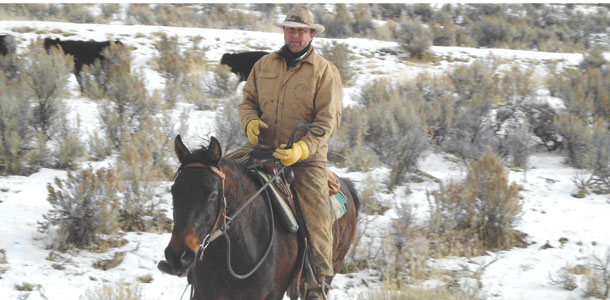 The goal is to be economically and ecologically sustainable, eliminating the use of harvested and stored feeds. The ranch is managed by Stacy Davies, who is also involved in Country Natural Beef.
The goal is to be economically and ecologically sustainable, eliminating the use of harvested and stored feeds. The ranch is managed by Stacy Davies, who is also involved in Country Natural Beef.
“The cattle industry in Harney County was the original industry, beginning in the 1870s, and continues to be the stable industry,” says Davies.
“Timber came and went, tourism is good when the economy is good but drops off immediately when the economy falters,” he says.
“The cattle industry began with the cattle barons’ large herds, followed by homesteaders’ herds.
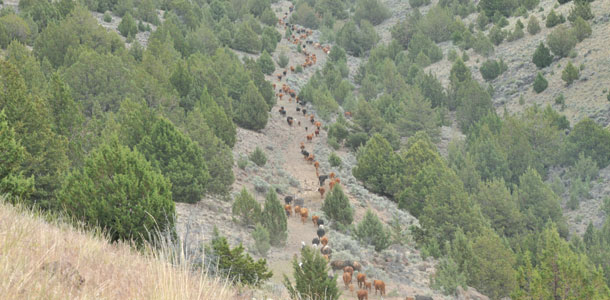 “In the late 1800s and early 1900s, thousands of homesteaders came here to farm and failed. The only ones that stayed were those that relied on livestock,” says Davies.
“In the late 1800s and early 1900s, thousands of homesteaders came here to farm and failed. The only ones that stayed were those that relied on livestock,” says Davies.
“There’s a reason for this, and the reason is bunchgrass. That’s what nature provides in southeast Oregon.
“It’s a renewable resource that can be harvested annually with livestock. Sheep, cattle and horses are hardy enough to survive here, and cattle are the most abundantly marketable,” he explains.
The culture that exists in eastern Oregon is one of animal husbandry combined with the art and skill of handling horses and cattle.
The buckaroo culture had its roots in early days of vaqueros and the first ranches in the area – influenced by Spanish traditions of California.
“This culture is still alive and well,” Davies says. “Young men and women are willing to give up fame and fortune to live this lifestyle and be part of this culture.
“This set of skills is unique to these ranches. It was a necessity on these open ranges to be able to get the job done. It’s also a culture that people have a lot of pride in.”
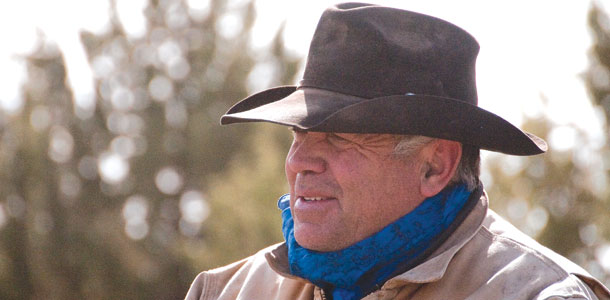 Doverspike Ranch
Doverspike Ranch
Mark and Susan Doverspike and their son, Steven, live near Burns on a family ranch that has been in operation since 1888.
Susan is fourth-generation. “Steven makes the fifth, and we now have a sixth generation with two grandchildren,” says Susan.
“My great-great-grandfather and his two sons came to California from the East. They rode horses up through Oregon to Washington and picked out places near Burns and Lakeview to settle.
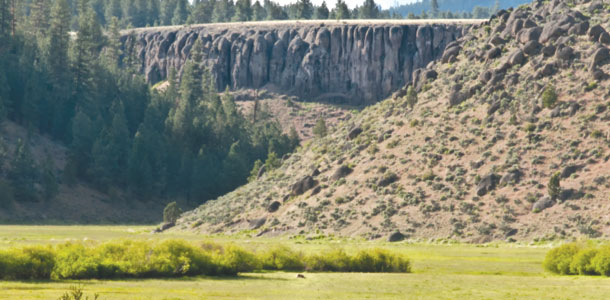 Our side of the family ended up in Burns. We’ve expanded the ranch with each generation,” she says.
Our side of the family ended up in Burns. We’ve expanded the ranch with each generation,” she says.
This is a cow-calf and yearling operation with Angus-Hereford cattle. “We sell some calves in the fall and hold some over to sell as yearlings in July,” says Mark.
“This region has good summer grass, but winters are long. “We start grazing crested wheat in early spring, and by May, the warmer-season grasses start growing,” says Steven.
“They stop growing by late July on a good year, or end of June on a dry year.”
The native meadows are harvested as hay and baled for winter feed. Re-growth provides fall pasture. “We feed hay during winter.
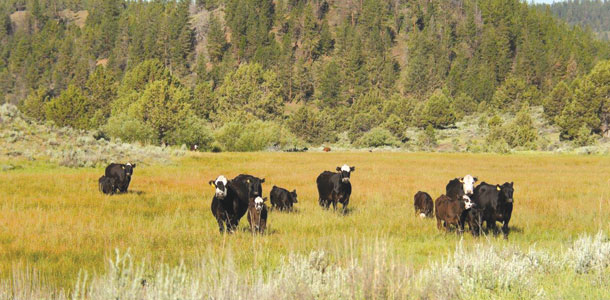
“In March, the cattle go to our calving grounds on sagebrush hills – a healthier environment for the calves than wet meadows. We have to feed hay there while we’re calving,” says Steven.
“In late April, the cattle go up into juniper steppes (BLM pastures) that provide early spring grazing. We go into pastures that we didn’t graze the year before, with old grass from the previous year,” he says.
“After that the cattle go up into the forest for summer. In the late fall, we use a mountain ranch with native meadows that we hay and rake-bunch for fall feed.”
Rake-bunch hay (in piles) preserves protein at the level it was when cut.
“At Burns, we generally get about 2 feet of snow, but snow depth varies on the mountains,” says Steven.
“We probably average 2 to 3 feet in the lower regions. Up on the higher mountains, the fences are covered. Usually we’re feeding hay through December until late April.”
The yearlings that are held over are sent to one of their ranches near Riley, about 40 miles west of Burns.
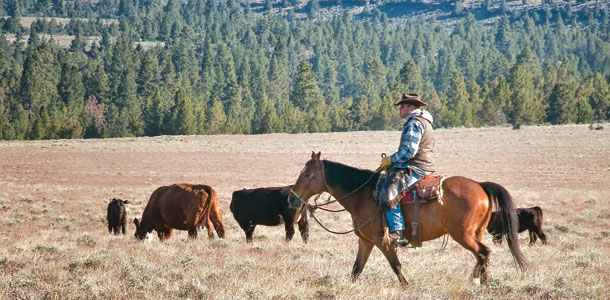
“They go on some native grass but mainly crested wheat. The yearlings stay there during summer and are ready to market in July,” says Steven.
It’s a challenge, tweaking the genetics to create cattle to fit the environment. “In this high-desert country, we can’t get too high on milk production or the cows won’t be able to stay in the herd,” says Susan.
“Sustainability is important because the high desert is a harsh environment. Our range pastures are rated as about 15 acres per cow per month,” says Steven.
The cattle follow the grass readiness, moving higher in elevation as summer progresses. The ranch meadows are just over 4,000 feet elevation, and range pastures go up to 6,000 feet.
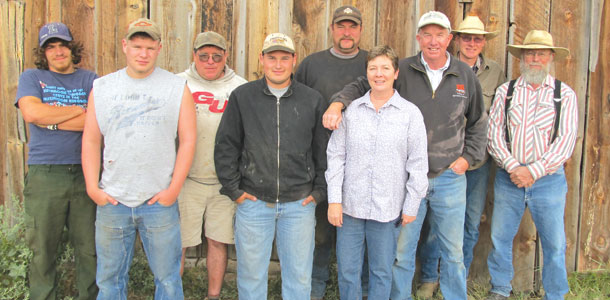
Southworths
Jack and Teresa Southworth live on the south side of the Strawberry Mountains in Bear Valley. “Our ranch was homesteaded in 1885 by my grandfather,” says Jack.
“He grew hay for oxen used at his sawmill. He then made it into a cattle ranch. His question was, ‘Can I make a living here?’ because no one ever had.”
Jack’s grandparents had three boys and put them all through college. “That was the definition of success for my grandfather: He started with nothing, educated his sons, and one of them – my father – took over the ranch,” says Jack.
“My father was a World War II veteran and came back to the ranch with a very scientific background. He thought that with enough machinery, equipment, research and new technology, we could solve all the problems.
“He felt there were ways to conquer the challenges, whether with scours boluses, growth implants or a new variety of grass.
“This worked for him because energy was relatively cheap, land was cheap, and he could use new technology to improve the ranch,” Jack says.
“In 1978, when Teresa and I took over the ranch, we (and my parents) bought some additional ground, and suddenly we were a million dollars in debt with 15 percent interest rates.
“It was killing us, but we didn’t know what to do.”
In 1984, Jack and Teresa took a week-long class from Allan Savory. “That was our first exposure to holistic management.
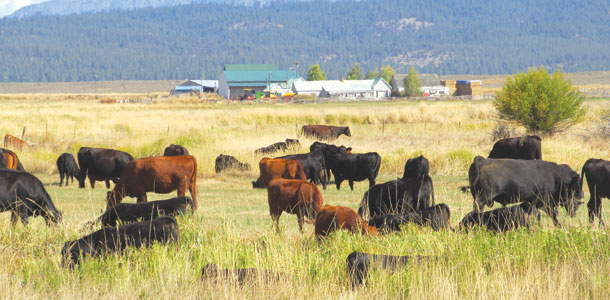
“I heard the part about economic analysis – and gross margin analysis – and how to determine whether we should be in the cow-calf business or yearling business.
“We learned more about how to manage our grass and whether we should build additional fence,” he says.
The economic analysis helped them start turning a corner. They were able to reduce their debt and increase their cowherd.
“Eventually, we also made a three-part goal. We realized it wasn’t just about measuring success through profit.
“It became measuring success by how well we achieved our quality of life goal, our production goal and our landscape goal,” he says.
“The purpose of the ranch is to allow each of us – owners and employees – to achieve our personal goals.
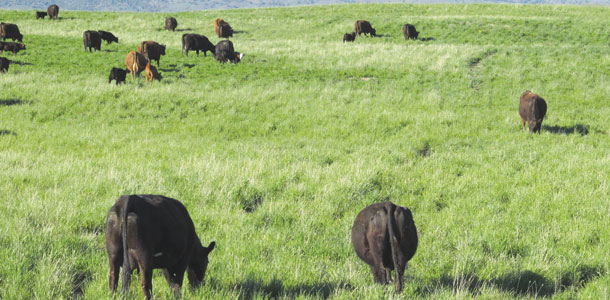
Our production goal is to make a profit from cattle and timber from the ranch. Our landscape goal is a dense stand of perennial grasses, with our streams lined with willow, stocked with beaver and good habitat for fish.
“We want our timberland to be a mosaic of openings and thickets – a forest of old growth and young trees of different species,” says Jack.
“We had a vision to manage toward, and as a result we’ve been able to reduce our debt and manage for quality of life as well as profit while heading toward the landscape goal that we believe will sustain us in the future.”
The Southworths use an A.I. program on their best-producing cows and grow their own bulls with the genetics they want, acclimated to their own conditions and harsh environment.
The grass only grows for about three months. “If we graze a plant hard on July 15 – near the last day of growing season – it requires almost a full year to recover and be ready to be grazed again,” he says.
“We are one of the coldest places in Oregon with a record low temperature of -54ºF. Snow varies from 6 inches to a couple feet, depending on the year.”
Hay costs are reduced with rake-bunched hay for the cattle to eat in the fall and early winter. Through the rest of the winter, the cattle are fed big round bales put up on the ranch.
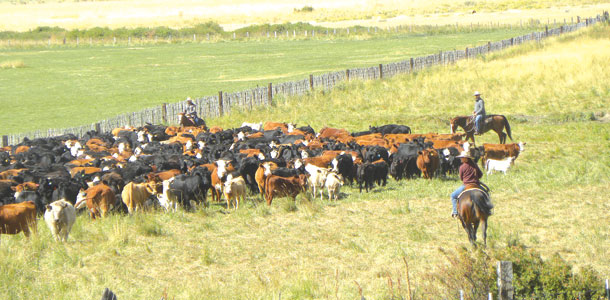
One thing that defines ranching in eastern Oregon is dependency on public land grazing. “These public lands are crucial.
“Without them, we don’t have the balance and diversity of grazing to allow us to be economically viable,” says Jack.
Most ranches don’t have adequate grazing on the home place; cattle must be somewhere else on summer pasture so hay can be grown on privately owned acres, for winter feed.
“I think our society is beginning to recognize the importance of the stewardship that ranchers provide. We are not out to rape and pillage the landscape.
“We use cattle as a tool to create a healthier and more diverse landscape,” says Jack. ![]()
Heather Smith Thomas is a freelance writer based in Idaho.
PHOTOS
PHOTO 1: Greetings from Progressive Cattle Country Oregon.
PHOTO 2: Stacy Davies moves some cattle in winter at the Roaring Springs Ranch.
PHOTO 3: Cattle gather off the forest and head toward private acreage. Photos courtesy of Roaring Springs Ranch.
PHOTO 4: Mark Doverspike.
PHOTO 5: The mountain ranch meadows at Doverspike Ranch.
PHOTO 6: Cattle graze on the meadow in the Hunter Cabin area.
PHOTO 7: Steven Doverspike rides the BLM land, while forest permit areas used by the ranch are seen in the distance. Photos by Susan Doverspike/Doverspike Ranch.
PHOTO 8: The crew at the Southworths’ ranch.
PHOTO 9: Southworth cattle shown near the ranch’s headquarters in Bear Valley.
PHOTO 10: The Southworths’ cattle graze crested wheat.
PHOTO 11: Southworth cattle are moved from one pasture to another.Photos courtesy of Jack and Teresa Southworth.
Importance of grazing
The cattle industry is the best fit for this area; the climate is not conducive to crops. The growing season is short, and native grasses do best.
“Typically, we have only about 70 frost-free days,” says Stacy Davies. “We have about 12 inches of precipitation and limited irrigation water.
“The high desert is bitterly cold in winter. Native bunchgrasses are hardy enough to thrive and produce strong forage. Livestock do well on it.
“On our ranch, the valleys are open enough that we can graze through winter, so we save forage in the valley floor. Some operations put up hay and feed hay, and we do some of that.
“But we are mainly using what nature provides as a renewable resource – converting grass into a salable product (meat). This is the key to our high-desert economy,” he explains.
“Ranching dovetails with nature. With healthy ranching economies, we can continue to have wide-open spaces wildlife depend on.
“Ranching is the only use that simply harvests what nature provides in a harmonious manner that allows the natural process to continue around us,” says Davies.
Ranching enhances rather than disrupts the environment because proper grazing is necessary to a healthy native plant community. Grass and grazer exist in a symbiotic relationship.
“All other uses of the land disrupt or fight nature or completely change the landscape – whether it’s farming where you plow it under or wind farms where you put up big towers and power lines and roads to get to them.
“Even recreational activities are disruptive compared to grazing animals.” Vehicular traffic, bicycle trails or facilities people use for recreational use change the landscape.
“Grazing animals are the least disruptive. If we wanted to, on our operation, we could eliminate all fossil fuel use.
“We could put another 10 cowboys on the payroll and go back to doing things like the times when everything was done horseback. There are no other uses of the land that could completely eliminate their use of fossil fuels.”








